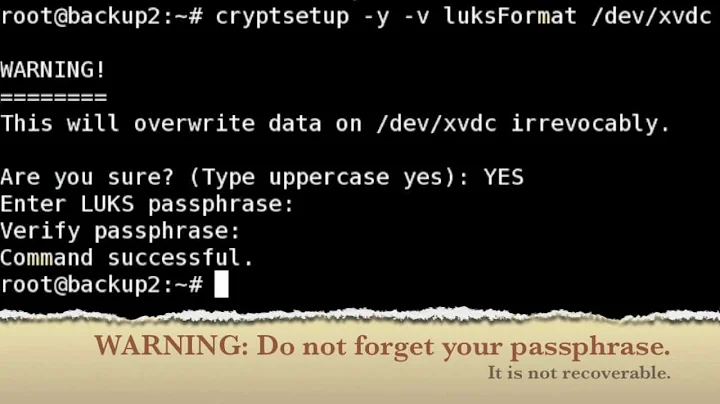cryptsetup: Cannot wipe header on device
Solution 1
One fellow solved this (or very similar) error by manually writing zeros to the first few megs of the target partition with a line similar to this:
dd if=/dev/zero of=[target] bs=1M count=2
Or if it's just an overwriting FS problem, then wipefs might work instead of / with the above.
Also, another used the "--debug" option with cryptsetup to get more information, it's worth a try first.
The "Update II" info tests use /dev/sdb1 and then /dev/sdb, not sure it would make a difference though.
Another guy here says "I've had floppies, thumb drives and hard drives have 'sector 0' issues that were all fixed by going into a Linux Live CD and wiping the first hundred sectors or so with dd if=/dev/zero of=/dev/hdN bs=1024 count=1024 "
This bug report comment about another external USB hard drive and a "end_request: critical target error, dev sdb, sector 0" seems to say Ubuntu 12.04 worked while 14.04 didn't. Others say it's probably a bad or inadequate USB power supply or failing hardware (enclosure, wires, hard drive)
So mixed results & advice. I've not had the best luck with USB enclosures either, I'd be inclined to try a different enclosure or a direct to desktop/esata cable connection.
Solution 2
I'm aware that this question is very old, but I was looking for a solution for the same error message, "Cannot wipe header on device", and found a solution that is not listed here: if the cryptsetup luksFormat output also includes the following:
WARNING: Data offset is outside of currently available data device.
then the partition is too small.
You're most likely to run into this if you are creating a partition that is meant to just contain a key file to encrypt other partitions.
It appears that with cryptsetup 2.1.0, the LUKS header takes up just under 16MiB (see below for details), so the partition size must 16MiB + the size of the key you want to store in it (3MiB, say).
For illustration, with an 8MiB partition, I saw the following error:
$ sudo cryptsetup luksFormat ${/dev/keypartition} --debug
[...]
# Formatting LUKS2 with JSON metadata area 12288 bytes and keyslots area 16744448 bytes.
[...]
WARNING: Data offset is outside of currently available data device.
Device wipe error, offset 8388608.
Cannot wipe header on device /dev/sda2.
Note that 12288 bytes + 16744448 bytes = 15.98 MiB.
With the size of /dev/sda2 increased to 19MiB, I successfully set it up as a LUKS partition.
Note: cryptsetup luksFormat also worked with dev/sda2 at 16MiB, but a subsequent cryptsetup luksOpen failed with
Requested offset is beyond real size of device /dev/sda2.
Increasing /dev/sda2 further to 32MiB fixed this issue, but when I tried to use the partition as a key file, cryptsetup luksFormat --key-file=/dev/mapper/<mountpoint of /dev/sda2> <device to encrypt> failed with
Maximum keyfile size exceeded.
There are two solutions to this: (1) set the size of the partition containing to key to 16MiB + key file size ensuring that the key file size is less than the maximum; (2) use the --keyfile-size option so cryptsetup luksFormat only uses some part of the key file.
Related videos on Youtube
Luís de Sousa
Member of the PyWPS Project Steering Committee; Charter Member of the OSGeo Foundation. Unix/Linux user since 1996. Experiencing Ubuntu since 2007, using it as main OS at home and office since 2009. Check my projects at Codeberg. More about what I do is in my personal web site. Follow me at Mastodon.
Updated on September 18, 2022Comments
-
 Luís de Sousa over 1 year
Luís de Sousa over 1 yearI am trying to encrypt an external hard drive on Ubuntu 14.04 followig this guide. I started by formatting to ext4:
$ sudo mkfs.ext4 /dev/sde1 mke2fs 1.42.9 (4-Feb-2014) Filesystem label= OS type: Linux Block size=4096 (log=2) Fragment size=4096 (log=2) Stride=0 blocks, Stripe width=0 blocks 9773056 inodes, 39072470 blocks 1953623 blocks (5.00%) reserved for the super user First data block=0 Maximum filesystem blocks=4294967296 1193 block groups 32768 blocks per group, 32768 fragments per group 8192 inodes per group Superblock backups stored on blocks: 32768, 98304, 163840, 229376, 294912, 819200, 884736, 1605632, 2654208, 4096000, 7962624, 11239424, 20480000, 23887872 Allocating group tables: done Writing inode tables: done Creating journal (32768 blocks): done Writing superblocks and filesystem accounting information: doneAnd then proceeded with the initialisation, but it returns this error:
$ sudo cryptsetup -y -v luksFormat /dev/sde1 WARNING! ======== This will overwrite data on /dev/sde1 irrevocably. Are you sure? (Type uppercase yes): YES Enter passphrase: Verify passphrase: Cannot wipe header on device /dev/sde1. Command failed with code 5: Cannot wipe header on device /dev/sde1.So far I could not anything useful on the web regarding this error. Any ideas on what may be wrong?
Update I: answering the questions posed by Xen2050. I ran
bablocksin write mode prior to formatting and no errors were reported.I tried the ecryption again, paying more attention to systems messages. Here is the
dmesgoutput right after connecting the drive:$ dmesg [ 3208.032228] usb 2-1.4: new high-speed USB device number 7 using ehci-pci [ 3208.140990] usb 2-1.4: New USB device found, idVendor=059f, idProduct=0651 [ 3208.141001] usb 2-1.4: New USB device strings: Mfr=1, Product=2, SerialNumber=3 [ 3208.141024] usb 2-1.4: Product: LaCie Hard Drive USB [ 3208.141031] usb 2-1.4: Manufacturer: LaCie [ 3208.141037] usb 2-1.4: SerialNumber: 10000E000BD8A671 [ 3208.177576] usb-storage 2-1.4:1.0: USB Mass Storage device detected [ 3208.178112] scsi4 : usb-storage 2-1.4:1.0 [ 3208.178183] usbcore: registered new interface driver usb-storage [ 3209.176917] scsi 4:0:0:0: Direct-Access SEAGATE ST3160812A 3.AA PQ: 0 ANSI: 2 [ 3209.177561] sd 4:0:0:0: Attached scsi generic sg2 type 0 [ 3209.181342] sd 4:0:0:0: [sdb] 312581808 512-byte logical blocks: (160 GB/149 GiB) [ 3209.182337] sd 4:0:0:0: [sdb] Write Protect is off [ 3209.182348] sd 4:0:0:0: [sdb] Mode Sense: 53 00 00 08 [ 3209.183339] sd 4:0:0:0: [sdb] Write cache: enabled, read cache: enabled, doesn't support DPO or FUA [ 3209.201618] sdb: sdb1 [ 3209.229465] sd 4:0:0:0: [sdb] Attached SCSI diskThen verified it is not mounted:
$ findmnt /dev/sdb $ findmnt /dev/sdb1 $Another try at initialisation:
$ sudo cryptsetup -y -v luksFormat /dev/sdb1 WARNING! ======== This will overwrite data on /dev/sdb1 irrevocably. Are you sure? (Type uppercase yes): YES Enter passphrase: Verify passphrase: Cannot wipe header on device /dev/sdb1. Command failed with code 5: Cannot wipe header on device /dev/sdb1.Two new lines show up in the log:
$ tail /var/log/syslog Dec 8 09:18:20 MekanikDestruktiwKommandoh kernel: [ 3698.016311] end_request: critical target error, dev sdb, sector 0 Dec 8 09:18:28 MekanikDestruktiwKommandoh wpa_supplicant[1188]: wlan0: CTRL-EVENT-SCAN-STARTEDSomething seems going wrong with sector 0, but not at all clear what.
Update II: Trying the new suggestions by Xen2050. First writing zeros to sector 0:
$ sudo dd if=/dev/zero of=/dev/sdb1 bs=1M count=10 10+0 records in 10+0 records out 10485760 bytes (10 MB) copied, 0.564427 s, 18.6 MB/sAfter this the
cryptsetupinitialisation still fails.wipefsreturns a strange warning:$ sudo wipefs -a /dev/sdb wipefs: WARNING: /dev/sdb: appears to contain 'dos' partition tableAnd apparently does nothing. Then ran
cryptsetupwith thedebugflag; it printed out a bunch of new stuff, but does not give more information regarding the error:$ sudo cryptsetup --debug -y -v luksFormat /dev/sdb # cryptsetup 1.6.1 processing "cryptsetup --debug -y -v luksFormat /dev/sdb" # Running command luksFormat. # Locking memory. # Installing SIGINT/SIGTERM handler. # Unblocking interruption on signal. WARNING! ======== This will overwrite data on /dev/sdb irrevocably. Are you sure? (Type uppercase yes): YES # Allocating crypt device /dev/sdb context. # Trying to open and read device /dev/sdb. # Initialising device-mapper backend library. # Timeout set to 0 miliseconds. # Iteration time set to 1000 miliseconds. # Interactive passphrase entry requested. Enter passphrase: Verify passphrase: # Formatting device /dev/sdb as type LUKS1. # Crypto backend (gcrypt 1.5.3) initialized. # Topology: IO (512/0), offset = 0; Required alignment is 1048576 bytes. # Generating LUKS header version 1 using hash sha1, aes, xts-plain64, MK 32 bytes # Crypto backend (gcrypt 1.5.3) initialized. # KDF pbkdf2, hash sha1: 356173 iterations per second. # Data offset 4096, UUID 5fa9c58f-b047-4c9e-a6e8-26a9a433a438, digest iterations 43375 Cannot wipe header on device /dev/sdb. # Releasing crypt device /dev/sdb context. # Releasing device-mapper backend. # Unlocking memory. Command failed with code 5: Cannot wipe header on device /dev/sdb.-
 Xen2050 over 8 yearsThat's an onion in the ointment... any more descriptive messages in /var/log/syslog?
Xen2050 over 8 yearsThat's an onion in the ointment... any more descriptive messages in /var/log/syslog?/dev/sde1isn't mounted while trying to luksFormat it? Maybe cryptsetup doesn't want to overwrite a mounted in-use partition... And it's still a "healthy" writeable drive? And the format to ext4 step should be after the luksFormat, but I think cryptsetup should be able to overwrite anything anyway, so that shouldn't stop it... -
 Xen2050 over 8 yearsHow strange, badblocks writes ok, mkfs.ext4 writes ok, but cryptsetup fails trying to write to sector 0... maybe a cryptsetup bug, I wonder if sdb1 contains a sector 0, or if it's trying to write to the very start of sdb (actually I'm not sure if drives start at sector 1 or 0, writing to a non-existing sector sounds like a critical error...) (No access to a regular browser now or I'd google that sector 0 error + cryptsetup)
Xen2050 over 8 yearsHow strange, badblocks writes ok, mkfs.ext4 writes ok, but cryptsetup fails trying to write to sector 0... maybe a cryptsetup bug, I wonder if sdb1 contains a sector 0, or if it's trying to write to the very start of sdb (actually I'm not sure if drives start at sector 1 or 0, writing to a non-existing sector sounds like a critical error...) (No access to a regular browser now or I'd google that sector 0 error + cryptsetup)
-




